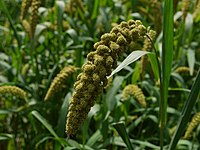
Photo from wikipedia
Broomcorn millet (Panicum miliaceum L.) is an important nutritious ancient minor-cereal food crop. However, this crop is little explored in the food processing arena to improve its functionality. In this… Click to show full abstract
Broomcorn millet (Panicum miliaceum L.) is an important nutritious ancient minor-cereal food crop. However, this crop is little explored in the food processing arena to improve its functionality. In this context, different processing methods were applied to enhance the secondary compounds of broomcorn millet. Four different individual methods such as roasting, steaming, puffing, and extrusion were applied at 110 °C to enhance the functional attributes of millet flour. It was observed that the significantly highest content of total phenolic (TP) (670 mg/100 g of ferulic acid equivalent) and total flavonoid (TF) (391 mg/100 g of rutin equivalent ) was attained in the roasted whole millet followed by steaming (315 mg/100 g, 282 mg/100 g), puffing (645 mg/100 g, 304 mg/100 g), extrusion (455 mg/100 g, 219 mg/100 g), and control (295 mg/100 g, 183 mg/100 g). The chromatographic analysis showed a greater content of single phenolic acids such as syringic acid, gallic acid, 4-hydroxy benzoic acid, ferulic acid, sinapic acid, and catechin in roasted millet compared to control, and the content of each acid was higher in whole millet than dehulled. Results also indicated that the content of ferulic acid was relatively higher among the quantified single phenolic acid from broomcorn millet. Likewise, in comparison with dehulled millet, the roasted whole millet showed higher total antioxidant capacity, measured by the 2,2-diphenyl-1 picryl hydrazyl (DPPH), the ferric reducing antioxidant power assay (FRAP), the phosphomolybdenum method (PPMD), and the hydroxyl radical scavenging capacity (HRSC) method. Lastly, it is concluded that the roasting method should be taken into consideration in the processing of broomcorn millet to enhance the content of nutraceutical compounds and improve its functionality.
Journal Title: Foods
Year Published: 2019
Link to full text (if available)
Share on Social Media: Sign Up to like & get
recommendations!